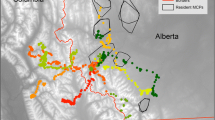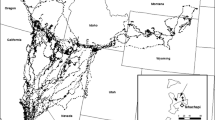Summary
To test their ability to home without searching or wandering, 19 juvenile alligators were radiotracked after displacement to areas 1–10 home range diameters beyond their areas of familiarity. Movement rates varied inversely with vegetation density, and in some cases habitat barriers appeared to deflect an alligator's homeward path. However, failures to home occurred only in those cases where major habitat barriers separated an alligator from its home site. In all other cases the alligators headed directly homeward; at least 10 of these completed their homeward journeys. The orienting ability of the alligators was neither dependent on the conditions under which they were displaced, nor the environmental conditions prevailing after release. These observations support the hypothesis that alligators possess a true navigational ability.
Similar content being viewed by others
References
Able KP (1980) Mechanisms of orientation, navigation and homing. In: Gauthreaux SA Jr (ed) Animal migration. Academic Press, New York, pp 282–383
Baker RR (1978) The evolutionary ecology of animal migration. Hodder and Stoughton, New York
Batschelet E (1972) Recent statistical methods for orientation data. In: Galler SR, Schmidt-Koenig K, Jacobs GJ, Bellevile RE (eds) Animal orientation and navigation. National Aeronautics and Space Administration, Washington, DC
Brezonik PL, Shannon EE (1971) Trophic state of lakes in north-central Florida. Fla Water Resources Res Center Publ 13
Chabreck RH (1966) The movement of alligators in Louisiana. Proc Southeast Assoc Game Fish Common, 19th Annu Conf 1965:102–110
Cowardin LM, Carter V, Golet FC, LaRoe ET (1979) Classification of wetlands and deepwater habitats of the United States. US Fish and Wildlife Service, Biological Services Program, Washington, DC
Deitz DC (1979) Behavioral ecology of young American alligators. Unpublished PhD thesis, University of Florida, Gainesville
DeRosa CT, Taylor DH (1980) Homeward orientation mechanisms in three species of turtles (Trionyx spinifer, Chrysemys picta, and Terrapene carolina). Behav Ecol Sociobiol 17:15–23
Fogarty MJ (1974) The ecology of the Everglades alligator. In: Gleason PJ (ed) Environments of South Florida; present and past. Mem Miami Geol Survey no 2:1–482
Keeton WT (1974) The orientational and navigational basis of homing in birds. Adv Study Behav 5:47–132
Author information
Authors and Affiliations
Rights and permissions
About this article
Cite this article
Rodda, G.H. Homeward paths of displaced juvenile alligators as determined by radiotelemetry. Behav Ecol Sociobiol 14, 241–246 (1984). https://doi.org/10.1007/BF00299494
Received:
Accepted:
Issue Date:
DOI: https://doi.org/10.1007/BF00299494




